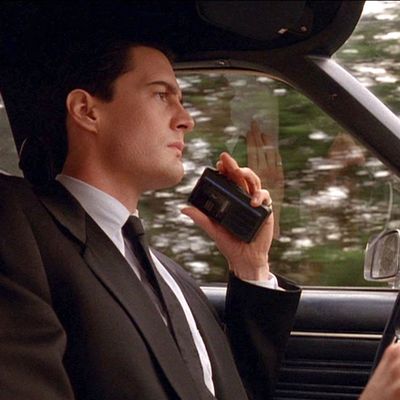
FBI Agent Dale Cooper enters the town of Twin Peaks and the Twin Peaks narrative about 35 minutes into the pilot. He’s driving and speaking into his cassette recorder, telling the unseen Diane about the itinerary of his trip, the merits of cherry pie at the Lamplighter Inn, and the majesty of his Pacific Northwest surroundings. “I’ve got to find out what kind of trees these are,” he says, marveling at how much beauty there is in the world while he speeds toward a hospital morgue to examine what lies beneath the fingernails of a murdered girl.
It is one of the most memorable character introductions in television history, not just because Kyle MacLachlan fully embodies this guy right from the word Diane, or because the unbroken, nearly two-minute shot so clearly signals Cooper’s significance. It’s a great entrance because it changes the energy of the show and starts to rearrange its molecular structure.
The first half-hour of that two-hour pilot, directed by David Lynch, certainly hints at the sordid darkness that will, in part, define the series. But much of what happens in those opening minutes also is weighed down in sobbing-and-heaving melodrama as news of Laura Palmer’s death spreds. When Cooper arrives with his combination of organized precision and childlike wonder — has he honestly never seen a Douglas fir before? — he operates on a whole new frequency that suggests that, in addition to being disturbing, Twin Peaks will also be pleasantly odd, prone to non sequiturs about nature and desserts, and as surreal as a fever dream. Cooper’s entrance may not be the moment that defines Twin Peaks, but it provides the fullest glimpse, to that point, of what its broader sensibility might be and how tied up that sensibility is in Cooper himself. That’s why when the special agent appears onscreen Sunday night for the first time in the Showtime iteration of Twin Peaks — assuming he reappears as Cooper, and not Bob-possessed Cooper or, for all I freakin’ know, an owl or a myna bird — I’ll be watching extra closely.
Agent Cooper is the most important, fascinating figure on Twin Peaks. He’s fascinating because his personality and the narrative roles he plays are so multifaceted. In the early episodes driven by the Palmer investigation, he’s the doughnut-eating detective, the clue-spotting navigator of what happens in the murder-mystery plot. But given his spontaneous staredowns with llamas and deadpan way with words (“Diane, I’m holding in my hand a small box of chocolate bunnies”), he’s also the provider of some of Twin Peaks’ best, most absurd comic relief.
With his perfectly slicked-back hair and admiration for the small-town values Twin Peaks represents, even if it doesn’t quite emulate them, he’s also the hero, a poster boy for American decency and ethics in law enforcement. (Boy, would I love to have a cup of coffee with Dale Cooper and ask him what he thinks about this whole James Comey situation.) And as Audrey Horne’s immediately obvious yearning attests, Cooper is also a sex symbol, especially when he slides into a tuxedo to go undercover at One-Eyed Jack’s. “You look like Cary Grant,” Blackie, the matron of One-Eyed Jack’s, tells him when he shows up dressed to the nines in the season-one episode “Realization Time.” As is true of many of the attractive people on Twin Peaks, there is something retro about his handsomeness; what draws you to him is both what you see in front of you, but also the memory of a dreamy movie-star man that exists in our collective, idealized imaginations. (Underlining that point: the fact that MacLachlan played the ghost of Cary Grant in the 2004 film Touch of Pink.)
Dream man feels like exactly the right term to use to describe Cooper, too, since what distinguishes him from the traditional, hard-nosed G-men we traditionally see on film is his reliance on metaphysics and intuition. Even the most casual Twin Peaks fan knows how important the subconscious is to this Lynchian American horror story, as established firmly in Cooper’s famous red room dream sequence in the episode “Zen, or the Skill to Catch a Killer.”
Hawk, the Log Lady, and others talk about something strange and otherworldly that’s always resided in the woods of Twin Peaks; Sarah Palmer and Maddie Ferguson both have strange visions. But Dale Cooper is the conduit through which the dreamy netherworld that’s later identified as the Black Lodge first finds its way into Twin Peaks. And as a testament to how important Cooper’s dream is, that’s the place where the series finale essentially ends, and where Cooper is overtaken by Bob. The final image of Cooper in Twin Peaks — or at least what had been the final image before this third season was made — is an image of him as a man possessed, taken over by the psychotic id who first appeared in that dream and promised to catch him with his death bag.
That’s a wildly different image of Cooper than the one we first see in the pilot. But in a way, even that introduction back in the pilot hints at what’s to come. When Cooper zooms into town, speaking a mile a minute to a woman who isn’t there, there’s a certain music in the air. It’s Angelo Badalmenti’s “Dance of the Dream Man,” the same finger-snapping tune from the red room. We don’t know the relevance of that song the first time we see Agent Cooper, but already Twin Peaks is subliminally telling us to keep our eyes open and pay attention to this man, when he’s wide awake, and even when he’s fast asleep and dreaming.


